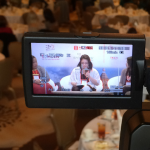Even as more organizations are repackaging their in-person experiences into digital event formats, the constant drumbeat sounds: Online can never replicate or replace face-to-face. So, do they leave virtual attendees feeling left behind? Or is it possible for digital learning programs to deliver the level of engagement audiences crave?
If the first-ever World Smart City Forum is any indication, it’s the latter — provided you commit to your online attendees. Hosted at the Marina Bay Sands in Singapore on July 13 by the International Electrotechnical Commission (IEC) in partnership with the International Organisation for Standardisation and the International Telecommunication Union, the program united architects, utility executives, transport planners, and a range of other city stakeholders around the world. From professionals working in cybersecurity, to transport, to waste management and other areas, there are many different suppliers involved in the infrastructure of a city. At the Forum, they aimed to tackle one big question: How can they develop guidelines that will make cities work more efficiently?
The program took a robust, multichannel approach to engagement. As a result, online participants were as active in the conversation as the more than 400 face-to-face attendees, with 1,000-plus community members watching the livestream broadcast from every continent except Antarctica, and the #WorldSmartCity2016 conversation reaching more than 600,000 people. “Our online audiences had the option of submitting questions over email, chat, and social media,” said Sylwia Korsak, social-media consultant for IEC. “They could participate in our virtual event through social media and also through the central event platform.”
The entire Forum was broadcast live on Ustream, a cloud-based platform designed to let anyone deliver a high-quality livestream to a global audience. Virtual attendees felt like they were part of the on-site action thanks to the opportunity to submit questions via Ustream, Twitter, and other online channels. With questions and comments coming from across the globe, Korsak assigned one IEC team member to collect them all in one place. “We also prepared our event moderator for Twitter discussion, so he was also checking our feed and hashtags for questions,” Korsak said. “Once collected, our events team supported our session moderators by delivering all online questions in a very traditional way — on paper.”
The activity on Twitter played another important role: maintaining engagement during downtime. The events team intentionally planned short breaks in the morning, afternoon, and lunch. “Our online community and partners continued discussions on Twitter,” Korsak said, “so we really did not have to provide any additional support.”
While it may seem surprising that virtual attendees were so active during a first-time event, they were accustomed to being part of a digital community. Starting in February, IEC offered a monthly series of Google Hangouts with academic and corporate leaders covering major pain points such as urban mobility, data privacy, and environmental sustainability; some of the Hangout speakers also appeared at the Forum. Korsak said the Hangouts were designed to send a message that the conversations were “open to all, accessible and inclusive.” “Our IEC communications team dedicated months building relationships with our community members to identify the right channels for questions [at the Forum],” Korsak said. “In the end, we decided to allow as many options as possible, but educate and encourage our audiences in the room and online to submit questions on chat and on Twitter primarily.”
That early introduction to digital interaction also empowered the events team’s decision-making in the planning stages. When they began selecting session topics for the Forum, they faced a big challenge: curating a program that could apply to a range of cities, large to small, developed to developing. A discussion about water treatment might matter to one city engineer, for example, while another might be searching for cybersecurity solutions to better manage resident data. To determine what trends and issues resonated with the majority of the audience, Korsak paid attention to the chatter during and after each Google Hangout.
“The great aspect of the online meet-ups was the fact that community questions represented a wide range of sectors and geographical locations, putting our speakers’ insights into more global perspective,” Korsak said. “We wanted to give our community the voice to suggest their topics, express their views, and point to their priorities. They helped us shape a program more relevant to all the attendees. ”




